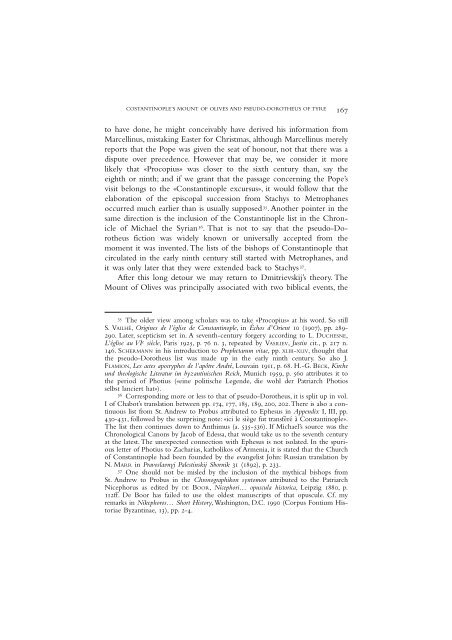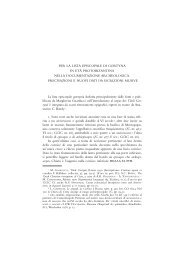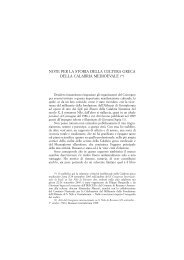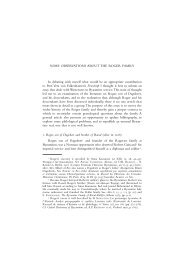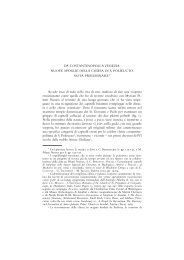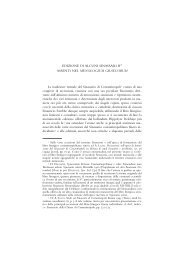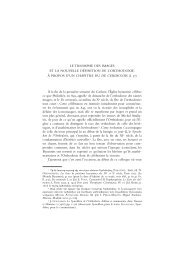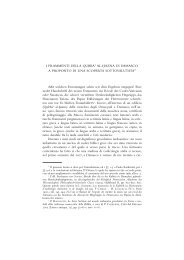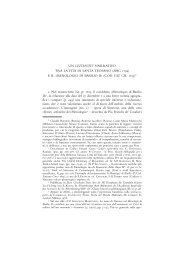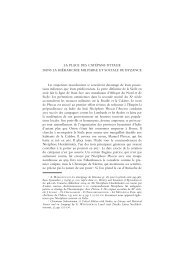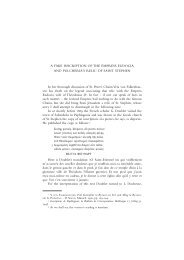CONSTANTINOPLE'S MOUNT OF OLIVES AND PSEUDO ...
CONSTANTINOPLE'S MOUNT OF OLIVES AND PSEUDO ...
CONSTANTINOPLE'S MOUNT OF OLIVES AND PSEUDO ...
Create successful ePaper yourself
Turn your PDF publications into a flip-book with our unique Google optimized e-Paper software.
COSTANTINOPLE’S <strong>MOUNT</strong> <strong>OF</strong> <strong>OLIVES</strong> <strong>AND</strong> <strong>PSEUDO</strong>-DOROTHEUS <strong>OF</strong> TYRE 167<br />
to have done, he might conceivably have derived his information from<br />
Marcellinus, mistaking Easter for Christmas, although Marcellinus merely<br />
reports that the Pope was given the seat of honour, not that there was a<br />
dispute over precedence. However that may be, we consider it more<br />
likely that «Procopius» was closer to the sixth century than, say the<br />
eighth or ninth; and if we grant that the passage concerning the Pope’s<br />
visit belongs to the «Constantinople excursus», it would follow that the<br />
elaboration of the episcopal succession from Stachys to Metrophanes<br />
occurred much earlier than is usually supposed 35 . Another pointer in the<br />
same direction is the inclusion of the Constantinople list in the Chronicle<br />
of Michael the Syrian 36 . That is not to say that the pseudo-Dorotheus<br />
fiction was widely known or universally accepted from the<br />
moment it was invented. The lists of the bishops of Constantinople that<br />
circulated in the early ninth century still started with Metrophanes, and<br />
it was only later that they were extended back to Stachys 37 .<br />
After this long detour we may return to Dmitrievskij’s theory. The<br />
Mount of Olives was principally associated with two biblical events, the<br />
35 The older view among scholars was to take «Procopius» at his word. So still<br />
S. VAILHÉ, Origines de l’église de Constantinople, in Échos d’Orient 10 (1907), pp. 289-<br />
290. Later, scepticism set in. A seventh-century forgery according to L. DUCHESNE,<br />
L’église au VI e siècle, Paris 1925, p.76 n. 3, repeated by VASILIEV, Justin cit., p. 217 n.<br />
146. SCHERMANN in his introduction to Prophetarum vitae, pp.XLIII-XLIV, thought that<br />
the pseudo-Dorotheus list was made up in the early ninth century. So also J.<br />
FLAMION, Les actes apocryphes de l’apôtre André, Louvain 1911,p.68. H.-G. BECK, Kirche<br />
und theologische Literatur im byzantinischen Reich, Munich 1959, p.560 attributes it to<br />
the period of Photius («eine politische Legende, die wohl der Patriarch Photios<br />
selbst lanciert hat»).<br />
36 Corresponding more or less to that of pseudo-Dorotheus, it is split up in vol.<br />
I of Chabot’s translation between pp. 174, 177, 185, 189, 200, 202.There is also a continuous<br />
list from St. Andrew to Probus attributed to Ephesus in Appendix I, III, pp.<br />
430-431, followed by the surprising note: «ici le siège fut transféré à Constantinople».<br />
The list then continues down to Anthimus (a. 535-536). If Michael’s source was the<br />
Chronological Canons by Jacob of Edessa, that would take us to the seventh century<br />
at the latest. The unexpected connection with Ephesus is not isolated. In the spurious<br />
letter of Photius to Zacharias, katholikos of Armenia, it is stated that the Church<br />
of Constantinople had been founded by the evangelist John: Russian translation by<br />
N. MARR in Pravoslavnyj Palestinskij Sbornik 31 (1892), p. 233.<br />
37 One should not be misled by the inclusion of the mythical bishops from<br />
St. Andrew to Probus in the Chronographikon syntomon attributed to the Patriarch<br />
Nicephorus as edited by DE BOOR, Nicephori… opuscula historica, Leipzig 1880, p.<br />
112ff. De Boor has failed to use the oldest manuscripts of that opuscule. Cf. my<br />
remarks in Nikephoros… Short History,Washington, D.C. 1990 (Corpus Fontium Historiae<br />
Byzantinae, 13), pp. 2-4.


